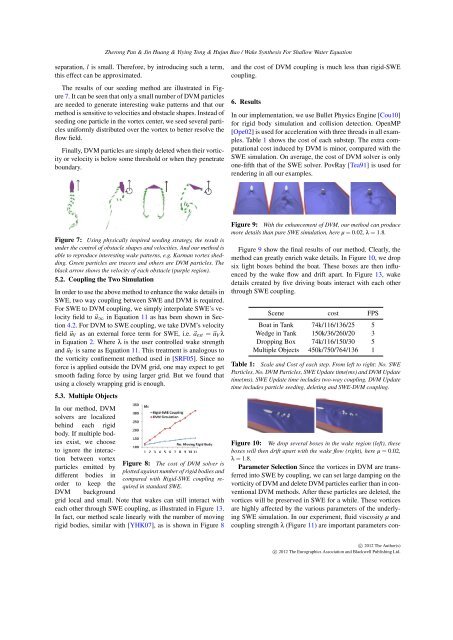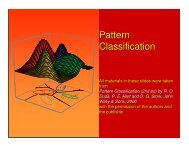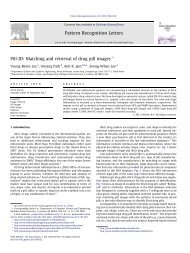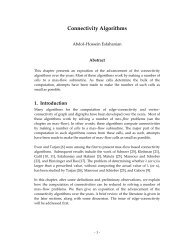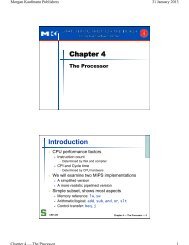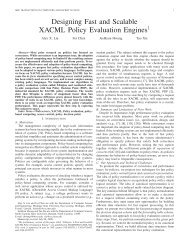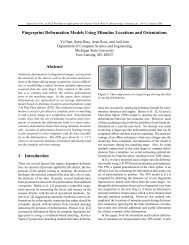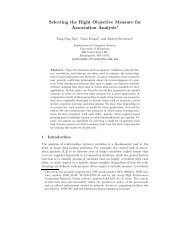Wake Synthesis For Shallow Water Equation - Department of ...
Wake Synthesis For Shallow Water Equation - Department of ...
Wake Synthesis For Shallow Water Equation - Department of ...
Create successful ePaper yourself
Turn your PDF publications into a flip-book with our unique Google optimized e-Paper software.
Zherong Pan & Jin Huang & Yiying Tong & Hujun Bao / <strong>Wake</strong> <strong>Synthesis</strong> <strong>For</strong> <strong>Shallow</strong> <strong>Water</strong> <strong>Equation</strong><br />
separation, l is small. Therefore, by introducing such a term,<br />
this effect can be approximated.<br />
The results <strong>of</strong> our seeding method are illustrated in Figure<br />
7. It can be seen that only a small number <strong>of</strong> DVM particles<br />
are needed to generate interesting wake patterns and that our<br />
method is sensitive to velocities and obstacle shapes. Instead <strong>of</strong><br />
seeding one particle in the vortex center, we seed several particles<br />
uniformly distributed over the vortex to better resolve the<br />
flow field.<br />
Finally, DVM particles are simply deleted when their vorticity<br />
or velocity is below some threshold or when they penetrate<br />
boundary.<br />
and the cost <strong>of</strong> DVM coupling is much less than rigid-SWE<br />
coupling.<br />
6. Results<br />
In our implementation, we use Bullet Physics Engine [Cou10]<br />
for rigid body simulation and collision detection. OpenMP<br />
[Ope02] is used for acceleration with three threads in all examples.<br />
Table 1 shows the cost <strong>of</strong> each substep. The extra computational<br />
cost induced by DVM is minor, compared with the<br />
SWE simulation. On average, the cost <strong>of</strong> DVM solver is only<br />
one-fifth that <strong>of</strong> the SWE solver. PovRay [Tea91] is used for<br />
rendering in all our examples.<br />
Figure 7: Using physically inspired seeding strategy, the result is<br />
under the control <strong>of</strong> obstacle shapes and velocities. And our method is<br />
able to reproduce interesting wake patterns, e.g. Karman vortex shedding.<br />
Green particles are tracers and others are DVM particles. The<br />
black arrow shows the velocity <strong>of</strong> each obstacle (purple region).<br />
5.2. Coupling the Two Simulation<br />
In order to use the above method to enhance the wake details in<br />
SWE, two way coupling between SWE and DVM is required.<br />
<strong>For</strong> SWE to DVM coupling, we simply interpolate SWE’s velocity<br />
field to ⃗u ∞ in <strong>Equation</strong> 11 as has been shown in Section<br />
4.2. <strong>For</strong> DVM to SWE coupling, we take DVM’s velocity<br />
field ⃗u V as an external force term for SWE, i.e. ⃗a ext = ⃗u V λ<br />
in <strong>Equation</strong> 2. Where λ is the user controlled wake strength<br />
and ⃗u V is same as <strong>Equation</strong> 11. This treatment is analogous to<br />
the vorticity confinement method used in [SRF05]. Since no<br />
force is applied outside the DVM grid, one may expect to get<br />
smooth fading force by using larger grid. But we found that<br />
using a closely wrapping grid is enough.<br />
5.3. Multiple Objects<br />
In our method, DVM<br />
solvers are localized<br />
behind each rigid<br />
body. If multiple bodies<br />
exist, we choose<br />
to ignore the interaction<br />
between vortex<br />
particles emitted by<br />
different bodies in<br />
order to keep the<br />
Figure 8: The cost <strong>of</strong> DVM solver is<br />
plotted against number <strong>of</strong> rigid bodies and<br />
compared with Rigid-SWE coupling required<br />
in standard SWE.<br />
DVM background<br />
grid local and small. Note that wakes can still interact with<br />
each other through SWE coupling, as illustrated in Figure 13.<br />
In fact, our method scale linearly with the number <strong>of</strong> moving<br />
rigid bodies, similar with [YHK07], as is shown in Figure 8<br />
Figure 9: With the enhancement <strong>of</strong> DVM, our method can produce<br />
more details than pure SWE simulation, here µ = 0.02, λ = 1.8.<br />
Figure 9 show the final results <strong>of</strong> our method. Clearly, the<br />
method can greatly enrich wake details. In Figure 10, we drop<br />
six light boxes behind the boat. These boxes are then influenced<br />
by the wake flow and drift apart. In Figure 13, wake<br />
details created by five driving boats interact with each other<br />
through SWE coupling.<br />
Scene cost FPS<br />
Boat in Tank 74k/116/136/25 5<br />
Wedge in Tank 150k/36/260/20 3<br />
Dropping Box 74k/116/150/30 5<br />
Multiple Objects 450k/750/764/136 1<br />
Table 1: Scale and Cost <strong>of</strong> each step. From left to right: No. SWE<br />
Particles, No. DVM Particles, SWE Update time(ms) and DVM Update<br />
time(ms). SWE Update time includes two-way coupling. DVM Update<br />
time includes particle seeding, deleting and SWE-DVM coupling.<br />
Figure 10: We drop several boxes in the wake region (left), these<br />
boxes will then drift apart with the wake flow (right), here µ = 0.02,<br />
λ = 1.8.<br />
Parameter Selection Since the vortices in DVM are transferred<br />
into SWE by coupling, we can set large damping on the<br />
vorticity <strong>of</strong> DVM and delete DVM particles earlier than in conventional<br />
DVM methods. After these particles are deleted, the<br />
vortices will be preserved in SWE for a while. These vortices<br />
are highly affected by the various parameters <strong>of</strong> the underlying<br />
SWE simulation. In our experiment, fluid viscosity µ and<br />
coupling strength λ (Figure 11) are important parameters conc○<br />
2012 The Author(s)<br />
c○ 2012 The Eurographics Association and Blackwell Publishing Ltd.


